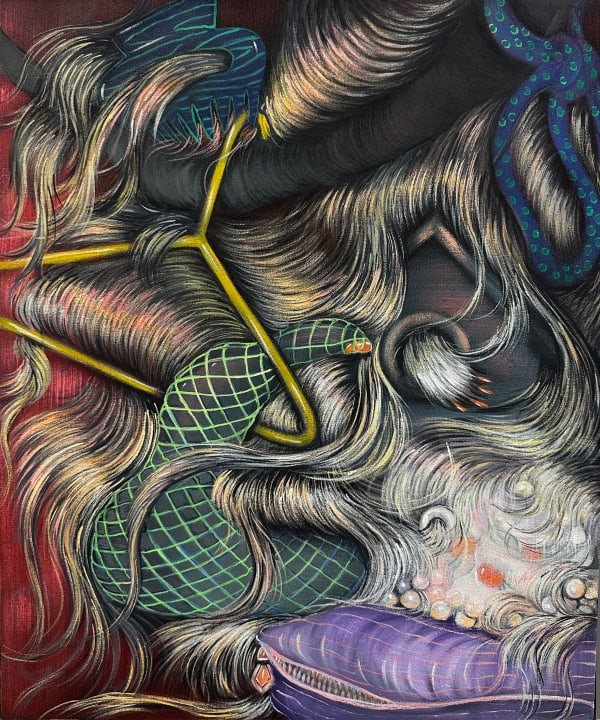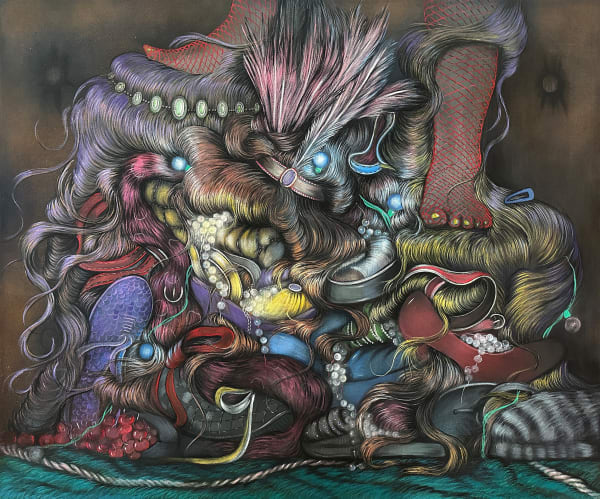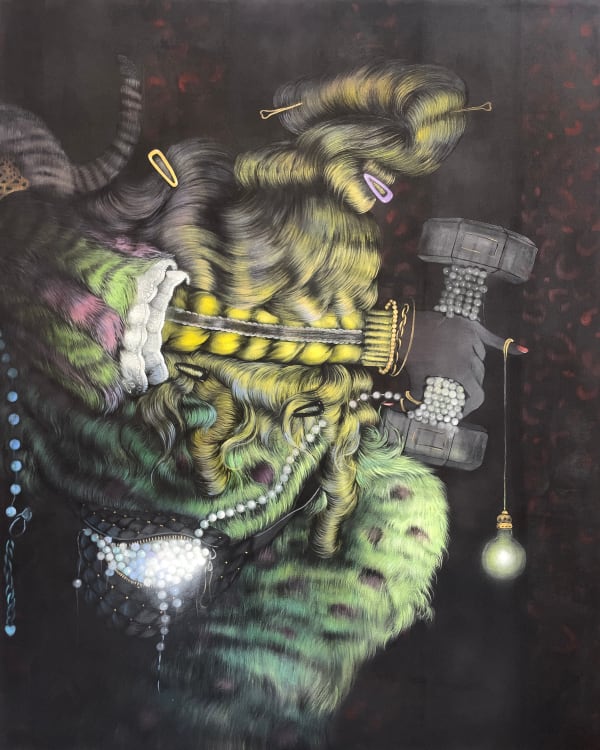"I paint artifices. My focus has always been the act of masking, of covering up, of literally putting oneself together. From my early passion for Erasmus’ In Praise of Folly, I could have guessed that my path would have gravitated around those themes. I am interested in representing our shapeshifting, dramatic, transformative selves. I’ve read about myths and fairytales, about metamorphosis and archetypes. I paint signifiers of artificial beauty, and we all know how feminine beauty can easily turn monstrous in our society. Women have been othered for centuries — in literature, visual art, and culture in general."
-
 Bea ScacciaMay I live on a tree and look at my mood swings from above?, 2025acrylic and airbrush on canvas101.6 x 121.9 x 3 cm
Bea ScacciaMay I live on a tree and look at my mood swings from above?, 2025acrylic and airbrush on canvas101.6 x 121.9 x 3 cm
40 x 48 x 1 1/8 in -
 Bea ScacciaCake, candle, swing, flying shoe, colorful stockings. Am I not perfectly alive?, 2025acrylic and airbrush on canvas182.9 x 152.4 x 4 cm
Bea ScacciaCake, candle, swing, flying shoe, colorful stockings. Am I not perfectly alive?, 2025acrylic and airbrush on canvas182.9 x 152.4 x 4 cm
72 x 60 x 1 5/8 in -
 Bea ScacciaExceptionally groomed in a flawed compression swing, 2025acrylic and airbrush on canvas182.9 x 152.4 x 4 cm
Bea ScacciaExceptionally groomed in a flawed compression swing, 2025acrylic and airbrush on canvas182.9 x 152.4 x 4 cm
72 x 60 x 1 5/8 in -
 Bea ScacciaGreen leaves can fall too-trust vs trash, 2025acrylic and airbrush on canvas101.6 x 101.6 x 3 cm
Bea ScacciaGreen leaves can fall too-trust vs trash, 2025acrylic and airbrush on canvas101.6 x 101.6 x 3 cm
40 x 40 x 1 1/8 in -
 Bea ScacciaStudy for swinging shoe and birdhouse, 2025acrylic and airbrush on canvas61 x 50.8 x 2.5 cm
Bea ScacciaStudy for swinging shoe and birdhouse, 2025acrylic and airbrush on canvas61 x 50.8 x 2.5 cm
24 x 20 x 1 in -
 Bea ScacciaStudy for swinging sock, 2025acrylic and airbrush on canvas50.8 x 40.6 x 2.5 cm
Bea ScacciaStudy for swinging sock, 2025acrylic and airbrush on canvas50.8 x 40.6 x 2.5 cm
20 x 16 x 1 in -
 Bea ScacciaStudy for swinging shoe, 2025acrylic and airbrush on canvas50.8 x 40.6 x 2.5 cm
Bea ScacciaStudy for swinging shoe, 2025acrylic and airbrush on canvas50.8 x 40.6 x 2.5 cm
20 x 16 x 1 in -
 Bea ScacciaStudy for swinging gloves, 2025acrylic and airbrush on canvas50.8 x 40.6 x 2.5 cm
Bea ScacciaStudy for swinging gloves, 2025acrylic and airbrush on canvas50.8 x 40.6 x 2.5 cm
20 x 16 x 1 in -
 Bea ScacciaBirds don’t dress me up, 2024acrylic and hairbrush on canvas91.4 x 76.2 cm
Bea ScacciaBirds don’t dress me up, 2024acrylic and hairbrush on canvas91.4 x 76.2 cm
36 x 30 in
-
 Bea ScacciaChatty But Shiny and Fit—with hidden cats, 2024acrylic and airbrush on canvas182.9 x 152.4 x 4 cm
Bea ScacciaChatty But Shiny and Fit—with hidden cats, 2024acrylic and airbrush on canvas182.9 x 152.4 x 4 cm
72 x 60 x 1 5/8 in -
 Bea ScacciaLook pretty, smell good and hide your cats, 2024acrylic and airbrush on canvas122 x 152 x 4.5 cm
Bea ScacciaLook pretty, smell good and hide your cats, 2024acrylic and airbrush on canvas122 x 152 x 4.5 cm
48 x 59 7/8 in -
 Bea Scaccia(I heard that shiny red attracts the eye) Are you intrigued? , 2025acrylic and airbrush on canvas101.6 x 121.9 x 3 cm
Bea Scaccia(I heard that shiny red attracts the eye) Are you intrigued? , 2025acrylic and airbrush on canvas101.6 x 121.9 x 3 cm
40 x 48 x 1 1/8 in -
 Bea ScacciaToo many thumbs, none green. I am such a doll with a cactus companion, 2025acrylic and airbrush on canvas182.9 x 152.4 x 4 cm
Bea ScacciaToo many thumbs, none green. I am such a doll with a cactus companion, 2025acrylic and airbrush on canvas182.9 x 152.4 x 4 cm
72 x 60 x 1 5/8 in -
 Bea ScacciaWhen tongues came out, we weren’t ready, 2025acrylic and airbrush on canvas190 x 200 x 4 cm
Bea ScacciaWhen tongues came out, we weren’t ready, 2025acrylic and airbrush on canvas190 x 200 x 4 cm
74 3/4 x 78 3/4 x 1 5/8 in -
 Bea ScacciaI don't mischievously lose my shoes anymore, 2025acrylic and airbrush on canvas101.6 x 121.9 x 3 cm
Bea ScacciaI don't mischievously lose my shoes anymore, 2025acrylic and airbrush on canvas101.6 x 121.9 x 3 cm
40 x 48 x 1 1/8 in -
 Bea ScacciaCatch a glipmse, 2024acrylic and airbrush on canvas152 x 122 cm
Bea ScacciaCatch a glipmse, 2024acrylic and airbrush on canvas152 x 122 cm
60 x 48 in -
 Bea ScacciaWeighing up her options, 2023acrylic and airbrush on canvas152 x 122 cm
Bea ScacciaWeighing up her options, 2023acrylic and airbrush on canvas152 x 122 cm
60 x 48 in -
 Bea ScacciaSoft candle and hard drink, 2024acrylic and airbrush on canvas152 x 122 cm
Bea ScacciaSoft candle and hard drink, 2024acrylic and airbrush on canvas152 x 122 cm
60 x 48 in -
 Bea ScacciaGattara Uno, 2023acrylic and airbrush on canvas183 x 152 cm
Bea ScacciaGattara Uno, 2023acrylic and airbrush on canvas183 x 152 cm
72 x 60 in
-

Mood Swings
Bea Scaccia 30.10 - 21.12.2025 Gallery | BrusselsPUBLIC OPENING October 30, 2025, 4 – 7 pm Avenue Louise 430, Brussels 1050 In the presence of the artist MARUANI MERCIER is delighted to present Bea Scaccia: Mood Swings...Read more -
 30 Years 2 - 31.8.2025 Gallery | Knokke KustlaanPUBLIC OPENING August 9, 2025, 11 am – 7 pm Kustlaan 90, Knokke 8300 Thirty years ago, MARUANI MERCIER opened its doors at rue de la Régence with a a...Read more
30 Years 2 - 31.8.2025 Gallery | Knokke KustlaanPUBLIC OPENING August 9, 2025, 11 am – 7 pm Kustlaan 90, Knokke 8300 Thirty years ago, MARUANI MERCIER opened its doors at rue de la Régence with a a...Read more -

Bea Scaccia
Wrap Yourself in This Skin 25 - 28.4.2024 Gallery | BrusselsThe series of paintings Wrap Yourself in This Skin , by New York-based Italian American painter Bea Scaccia, is thematically based on the French fairytale, Donkey Skin, and provides an...Read more
-

The Whimsy, the Feminine, the Gross and Everything in Between
By Sofia Crespo for METAL Magazine 19.11.2025 Read more -

Bea Scaccia: The unsentimental beauty in the world
By Saša Bogojev for The Unibrow 13.11.2025 Read more -

Fantastic but polite: Italian art in the mirror of curators
By Federico Giannini for Finestre sull'Arte 25.10.2025 Read more -

Bea Scaccia included in 18th edition of the Quadriennale di Roma ‘Fantastica’ at Palazzo delle Esposizioni
From October until January, 2025 11.7.2025 Read more -

Bea Scaccia's masks and artifices: "Style is our true soul, the surface our only depth"
By Georgia Aprosio for Il Giornale dell'Arte 23.4.2025 Read more -

The Art Pod: Bea Scaccia
Karolina Chojnowksa in conversation with Bea Scaccia 30.11.2024 Read more -

Bea Scaccia in Conversation with Giorgio Di Domenico
15.4.2024The Cooper Union and the Center for Italian Modern Art (CIMA) hosted a screening and discussion around five short documentaries developed by CIMA that showcase...Read more -

Rising Talent Bea Scaccia’s Otherworldly Paintings Capture the Harmony—and Tension—Between Beauty and Monstrosity
By Katie White for Artnet 4.7.2023 Read more
-

Art Basel Miami Beach 2025
3 - 7.12.2025We are delighted to announce our participation in Art Basel Miami Beach 2025, where we will present a thoughtfully curated selection of paintings, sculptures, and...Read more -
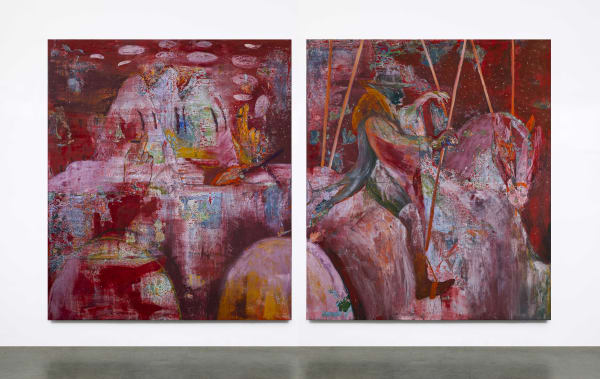
Art Brussels 2025
24 - 27.4.2025We look forward to returning to the 41st edition of Art Brussels with a group exhibition highlighting an eclectic range of works by artists including...Read more -
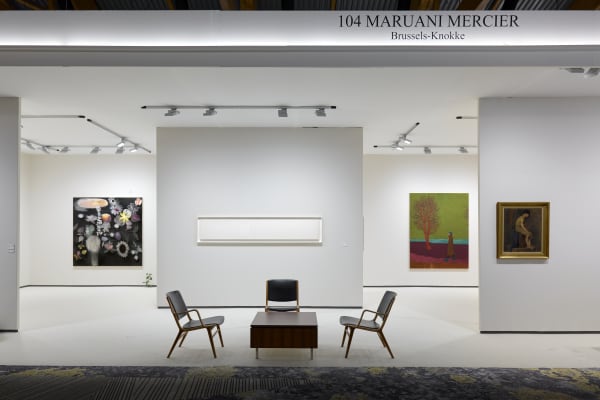
BRAFA 2025
26.1 - 2.2.2025We are pleased to return to BRAFA, celebrating its 70th edition, where we will present a group of historic works in tandem with contemporary highlights...Read more -

The Armory Show 2024
6 - 8.9.2024We are excited to return to The Armory Show, presenting a selection from our expanding roster of distinguished artists. Discover captivating works of our newly...Read more
-
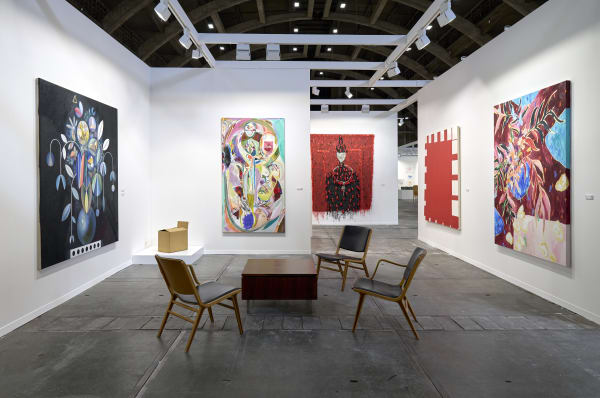
Art Brussels 2024
25 - 28.4.2024We look forward to returning to the 40th edition of Art Brussels with a group exhibition highlighting an eclectic range of works by artists including...Read more -
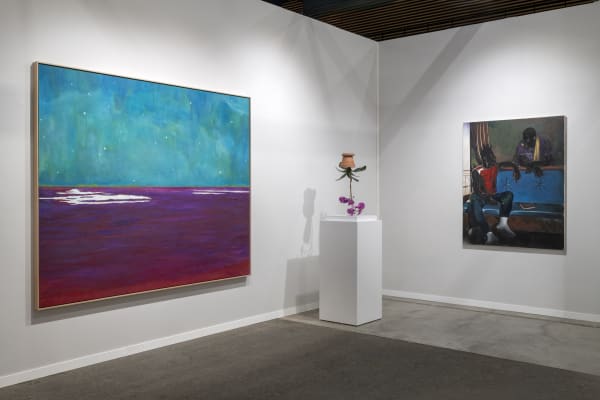
Art Paris 2024
4 - 7.4.2024We are thrilled to return to Art Paris 2024 with a selection of modern and contemporary works by Ojo Ayotunde , Ross Bleckner , Kwesi...Read more -
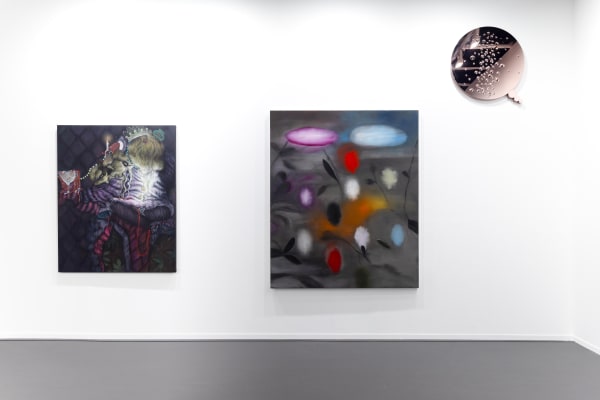
Art Dubai 2024
1 - 4.3.2024We are delighted to return to Art Dubai with an exquisite range of works by artists exemplary of our dynamic programme. This presentation includes a...Read more





